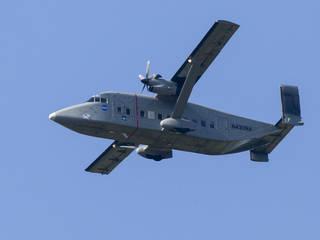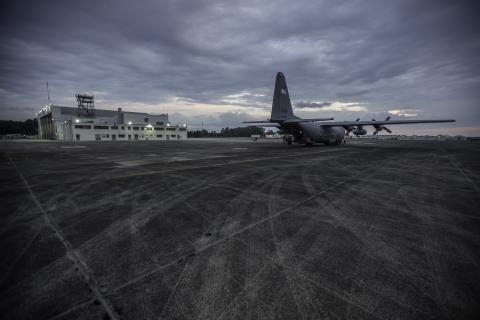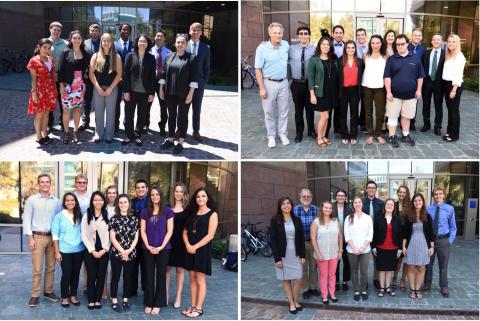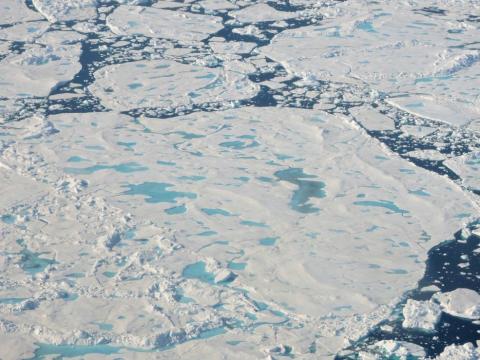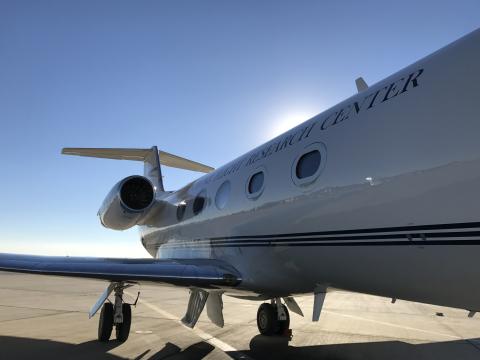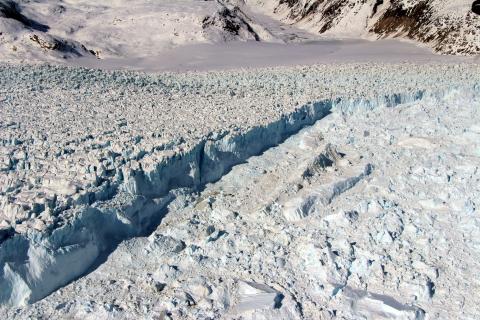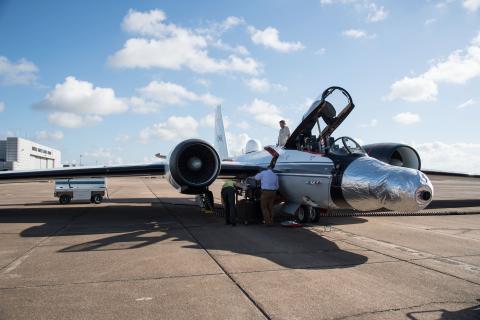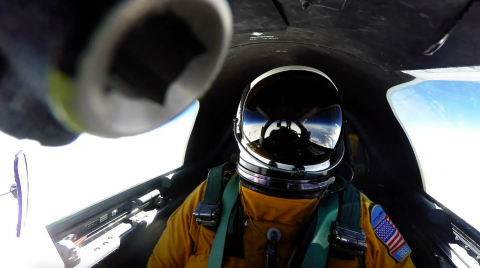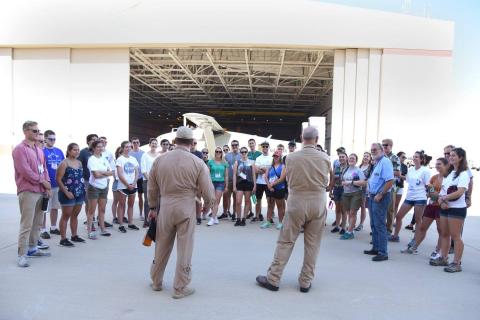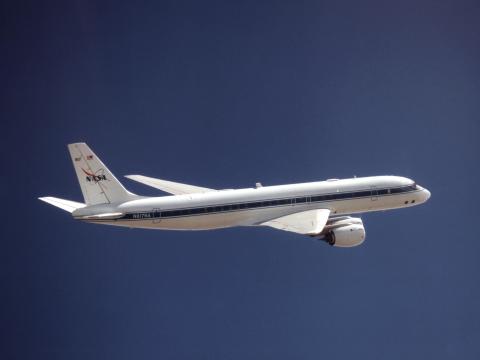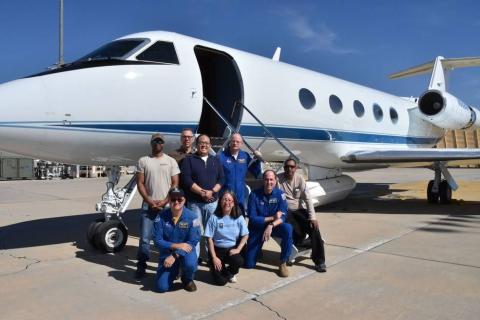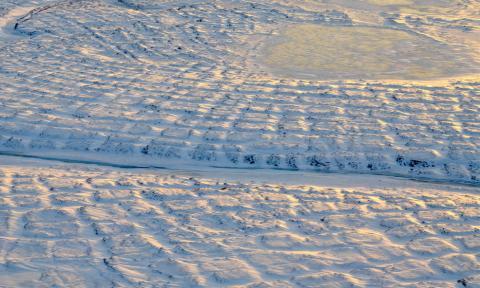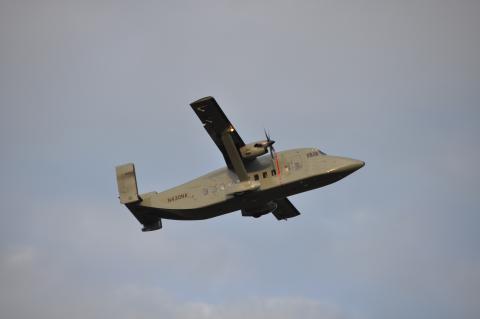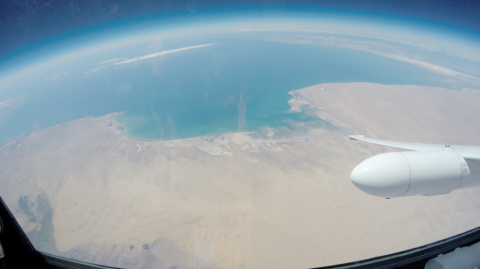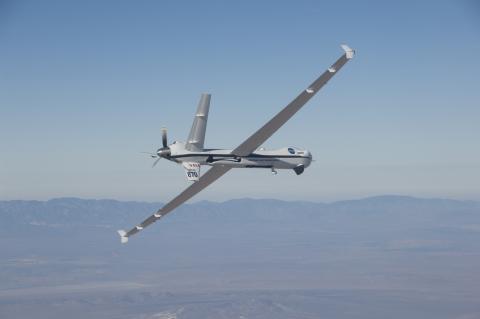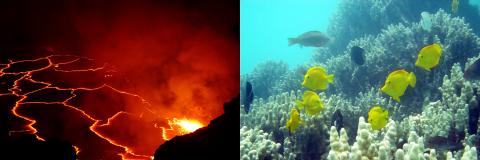New Greenland Maps Show More Glaciers at Risk
New maps of Greenland’s coastal seafloor and bedrock beneath its massive ice sheet show that two to four times as many coastal glaciers are at risk of accelerated melting as previously thought.
Researchers at the University of California at Irvine (UCI), NASA and 30 other institutions have published the most comprehensive, accurate and high-resolution relief maps ever made of Greenland's bedrock and coastal seafloor. Among the many data sources incorporated into the new maps are data from NASA's Ocean Melting Greenland (OMG) campaign.
IceBridge Launches Two Sets of Antarctic Flights
Scientists with NASA’s longest-running airborne mission to map polar ice, Operation IceBridge, completed a successful science flight on Oct. 29, inaugurating their 2017 survey of Antarctic sea and land ice. For the first time in its nine years of operations in the southern hemisphere, IceBridge will launch two consecutive, dedicated sets of Antarctic flights from two continents—South America and Antarctica—with two different aircraft and instrument suites.
ACT-America Aims to Tell Four-Season Greenhouse Gas Story
NASA scientists are once again on the hunt for greenhouse gases in the sky. Researchers for the Atmospheric Carbon and Transport-America, or ACT-America, study returned to the field last week to measure how weather systems transport carbon dioxide and methane through the atmosphere over the eastern part of the United States.
Global Airborne Mission to Make Ozone Hole Detour
Atmospheric researchers depart this month on NASA's DC-8 research aircraft on their third survey of the global atmosphere. Taking place for the first time in Northern Hemisphere fall, the season gives them the unique opportunity to make a detour from their previous flight paths to fly underneath the Antarctic ozone hole.
NASA Flights Map Summer Melt of Greenland Land Ice
Operation IceBridge is flying in Greenland to measure how much ice has melted over the course of the summer from the ice sheet. The flights, which began on Aug. 25 and will go on until Sept. 21, repeat paths flown this spring and aim to monitor seasonal changes in the elevation of the ice sheet.
NASA Chesapeake Bay Study To Help Improve Air-Quality Forecasts
The Ozone Water-Land Environmental Transition Study (OWLETS) is a NASA study looking at ozone concentrations around the lower Chesapeake Bay.
NAAMES Returns to Air and Sea to Study Plankton’s Annual Cycle
NASA’s North Atlantic Aerosols and Marine Ecosystems Study (NAAMES) returned to air and sea to research the declining, or deaccelerating, phase of the annual cycle of plankton in the North Atlantic. Since plankton form the base of the marine food web and impact the productivity of fisheries, understanding this declining phase is important to forecasting the future.
NASA Interns Complete Earth Science Summer Research Program
Thirty-two students from colleges and universities across the United States recently completed a NASA summer internship designed to provide them with an airborne Earth science research experience.
NASA Scientists Seek to Improve Sea Ice Predictions
NASA researchers are working to improve their forecasts of the size of the Arctic sea ice cover at the end of the summer melt season — but the goal is not just to have a better prediction of sea ice coverage. The challenge of making summer sea ice forecasts allows scientists to test their understanding of the processes that control seasonal sea ice growth and retreat, and to fine-tune computer models that represent connections among the ice, atmosphere and ocean.
On Aircraft, Armstrong Kicks off NASA TV Coverage of Solar Eclipse
A photographer and videographers from NASA Armstrong Flight Research Center in California will document the total solar eclipse Aug. 21, which they will be doing from a unique vantage point at about 25,000 feet altitude.
NASA-led Airborne Mission Studies Storm Intensification in Northern Hemisphere
A group of NASA and National Oceanic Atmospheric Administration (NOAA) scientists are teaming up this month for an airborne mission focused on studying severe storm processes and intensification. The Hand-On Project Experience (HOPE) Eastern Pacific Origins and Characteristics of Hurricanes (EPOCH) field campaign will utilize NASA’s Global Hawk autonomous aircraft to study storms in the Northern Hemisphere to learn more about how storms intensify as they brew out over the ocean.
NASA Airborne Mission Returns to Africa to Study Smoke, Clouds
NASA's P-3 research plane begins flights this month through both clouds and smoke over the South Atlantic Ocean to understand how tiny airborne particles called aerosols change the properties of clouds and how they influence the amount of incoming sunlight the clouds reflect or absorb.
Two Decades of Changes in Helheim Glacier
Since 1997, NASA has collected data over Helheim Glacier almost every year during annual airborne surveys of the Greenland Ice Sheet using an airborne laser altimeter called the Airborne Topographic Mapper (ATM). Since 2009 these surveys have continued as part of Operation IceBridge, NASA’s ongoing airborne survey of polar ice and its longest-running airborne mission. ATM measures the elevation of the glacier along a swath as the plane files along the middle of the glacier. By comparing the changes in the height of the glacier surface from year to year, scientists estimate how much ice the glacier has lost.
Chasing the Total Solar Eclipse from NASA’s WB-57F Jets
For most viewers, the Aug. 21, 2017, total solar eclipse will last less than two and half minutes. But for one team of NASA-funded scientists, the eclipse will last over seven minutes. Their secret? Following the shadow of the Moon in two retrofitted WB-57F jet planes.
Early Airborne Results Address South Korean Air Quality
For six weeks in the summer of 2016 scientists from the United States and the Republic of Korea intensively studied air pollution over the Korean peninsula. Their mission: to diagnose the complex causes of the country’s poor air quality and in so doing lay the groundwork for next-generation pollution monitoring from space that both nations plan to launch in the next few years.
Hunting for Lightning: A Day at the GOES-16 Post-Launch Field Campaign
A team of instrument scientists, meteorologists, and specialized pilots have used a high-altitude plane, ground-based sensors, and satellites to collect and compare measurements from across the United States to calibrate and validate the earth viewing instruments on NOAA’s GOES-16 satellite.
Students to Study Earth from Three NASA Flying Laboratories
This summer 32 undergraduate students are participating in an eight-week NASA airborne science field campaign designed to immerse them in the agency's Earth science research.
NASA Aids Study of Lake Michigan High-Ozone Events
NASA researchers are conducting science flights along the Wisconsin-Illinois Lake Michigan shoreline to help better understand the formation and transport of ozone, a potent air pollutant in the region.
Smoke from Wildfires Can Have Lasting Climate Impact
New research using data collected during NASA airborne science campaigns shows how smoke from wildfires worldwide could impact the atmosphere and climate much more than previously thought.
NASA's CPEX Tackles a Weather Fundamental
A NASA-funded field campaign underway in Florida has a real shot at improving meteorologists' ability to answer some of the most fundamental questions about weather: Where will it rain? When? How much?
NASA’s Arctic Ecosystem Science Flights Begin
A NASA-led effort to advance our ability to monitor changing Arctic and boreal ecosystems has started its second season, with the first aircraft taking flight over Alaska and northwest Canada this month.
NASA Polar Ice Survey Flights Conclude
NASA’s annual survey of changes in Arctic ice cover greatly expanded its reach this year in a series of flights that wrapped up on May 12. It was the most ambitious spring campaign in the region for NASA’s Operation IceBridge, an airborne mission to monitor ice changes at Earth’s poles, which also included a rapid-response flight over a new crack in Petermann Glacier, one of the largest and fastest-changing glaciers in Greenland.
Alaska Tundra Source of Early-Winter Carbon Emissions
Three years of observations from NASA’s Carbon in Arctic Reservoirs Vulnerability Experiment (CARVE) airborne mission were used in a new study that shows warmer temperatures and thawing soils may be driving an increase in carbon dioxide emissions from Alaskan tundra to the atmosphere.
NASA to Measure Greenhouse Gases Over the Mid-Atlantic Region
In May, a team of Goddard scientists will begin measuring greenhouse gases over the Mid-Atlantic region — an area chosen in part because it encompasses a range of vegetation, climate, and soil types that would influence the exchange of carbon dioxide and methane between the Earth and the atmosphere.
NASA's High-Altitude Plane Takes to the Sky for GOES-16 Field Campaign
A NASA ER-2 high-altitude plane has taken to the air to complete phase one of the 11-week GOES-16 Field Campaign to ensure NOAA's GOES-16 satellite provides precise satellite measurements, which will improve forecasting.
NASA’s P-3 Begins 2017 with IceBridge Support
The spring NASA Operation IceBridge campaign will take the P-3 to Greenland, Norway, and Alaska over the next 10 weeks. The P-3 last flew with IceBridge on their 2013 Arctic campaign, during which the aircraft made flights out of both Kangerlussuaq and Thule, Greenland.
NASA-Led Campaign Studies Hawaii’s Iconic Volcanoes
This month, a NASA-led science team is exploring Kilauea and the adjacent volcano Mauna Loa from the air, ground and space. Their goal: to better understand volcanic processes and hazards.
Probe May Improve Weather Forecasts
A weather probe that eventually will relay atmospheric conditions as they are unfolding and provide data to improve weather forecasts and models, has begun to fly on NASA’s Ikhana remotely piloted aircraft.
NASA Invites Media Behind the Scenes of Volcano, Coral Reef Research
NASA is hosting a media day on Feb. 8 in O’ahu, Hawaii, to spotlight two field campaigns that seek to unlock some of the mysteries behind two of Hawaii’s treasured natural resources: coral reefs and volcanoes.
Wallops Aircraft Supporting NASA Science Projects from Pole to Pole
The fleet of aircraft at the Wallops Flight Facility that support NASA’s airborne sciences program are preparing for a busy year as the agency continues several projects investigating critical scientific questions about how our planet is changing and what impacts humans are having on it.






